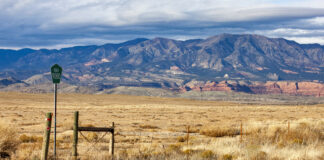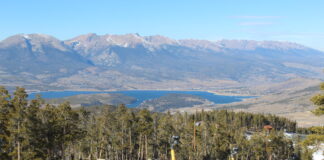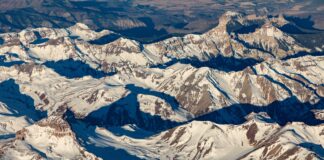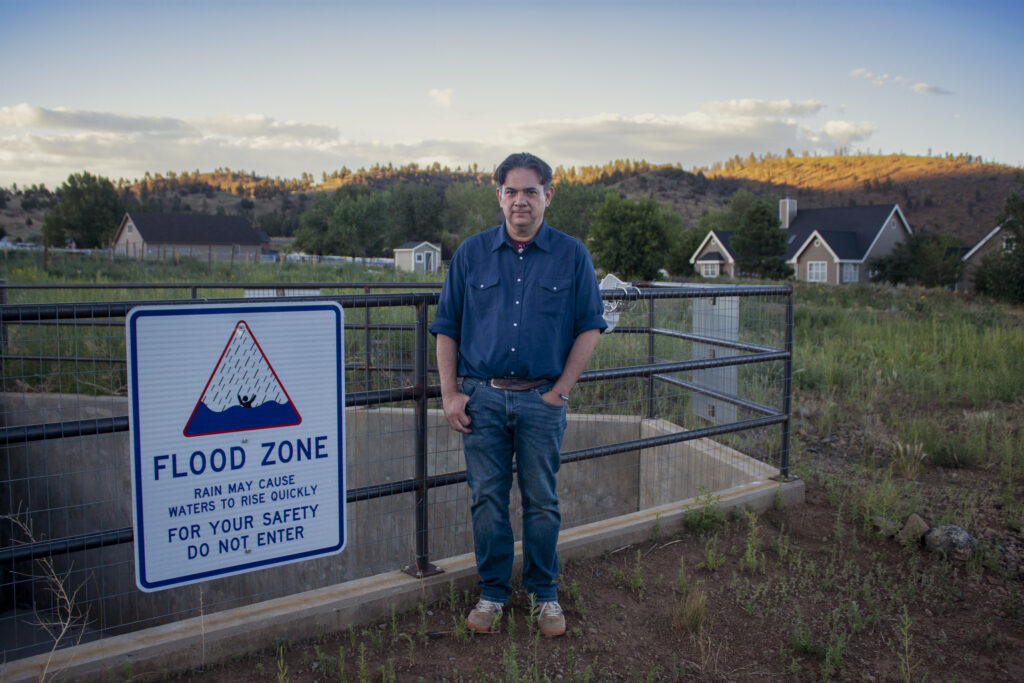
FLAGSTAFF, Ariz. – In July 2022, for the second time in a month, the landscape above the Wupatki Trails neighborhood took a beating.
The first blow was the Pipeline Fire, which ignited on June 12, 2022, and burned 26,770 acres mostly in Coconino National Forest including the slopes above Wupatki Trails and eight other forested drainages flowing into residential areas of Coconino County a few miles north of Flagstaff.
Danny Cobb, who had moved to the high desert of northern Arizona six months earlier from Anchorage, captured video of towering smoke plumes as he evacuated with his family. Ivan and Christy Pacheco, who live down the block, left as well.
Both families returned to the neighborhood with a feeling of relief. Their homes were still standing.
But then, weeks later, the second disruption in the forest occurred – borne not of fire but of water.
The southwest monsoon is an annual feature of Arizona weather. In the summer months, the punchy precipitation pattern delivers short, drenching cloudbursts – as much as several inches of rain in an hour. In Coconino County, the summer 2022 monsoon was a conveyor belt of destruction. A series of storms inflicted wave upon wave of property and infrastructure damage downstream of the Pipeline Fire burn scar. Lucinda Andreani, administrator of the Coconino County Flood Control District, counted 45 major flood events that summer that closed roads and flooded properties.
The summer storms whisked water off slopes and soils now charred by the fire. They flooded U.S. Route 89, a main highway heading north, some 13 times. They carved deep channels in the land, transported huge volumes of sediment, and pummeled homes with boulders larger than basketballs.
Christy Pacheco, a kayaker, called the murky torrent moving through their backyard a “class eight” whitewater. The top of the scale for Grand Canyon rapids is 10. “It was pretty powerful,” she said. The Pachecos stacked four layers of sandbags atop a berm on their property. When that wall started to fail, they grabbed wood panels and other supplies from their garage to act as makeshift levees.
“We were within half an inch of having all that mud and water coming in the house,” Ivan said.
A landscape coming apart at the seams that summer became the principal challenge for Andreani, other Coconino County and City of Flagstaff officials, and their long-time watershed restoration collaborators in the private sector. In the frantic months after the fire, they had a single, unifying mission that would shape the next year of their professional lives and become a $130 million endeavor:
Fix the watershed before it breaks again.
The disaster after the disaster
The western United States is experiencing an era of wildfire. From the ponderosa pine forests of Arizona and Colorado to the chaparral of Los Angeles County, wildfires are burning more acres with greater intensity. Recent research indicates their growth rate has accelerated, spreading flames with worrisome speed.
The shift is happening for several reasons. The region’s forests, owing partly to the U.S. Forest Service’s 20th century policy of fire suppression, are artificially crowded with kindling. A warming climate due to the accumulation of heat-trapping gases in the atmosphere is roasting the landscape and drawing moisture out of its vegetation. Bark beetles have killed or wounded tens of millions of acres of timber. The result is dense forests riven with dead and drying plants that are primed to burn.
Wildfire damage is immediate and obvious. Denuded forests, noxious smoke that drifts across continents, destroyed homes, lives lost.
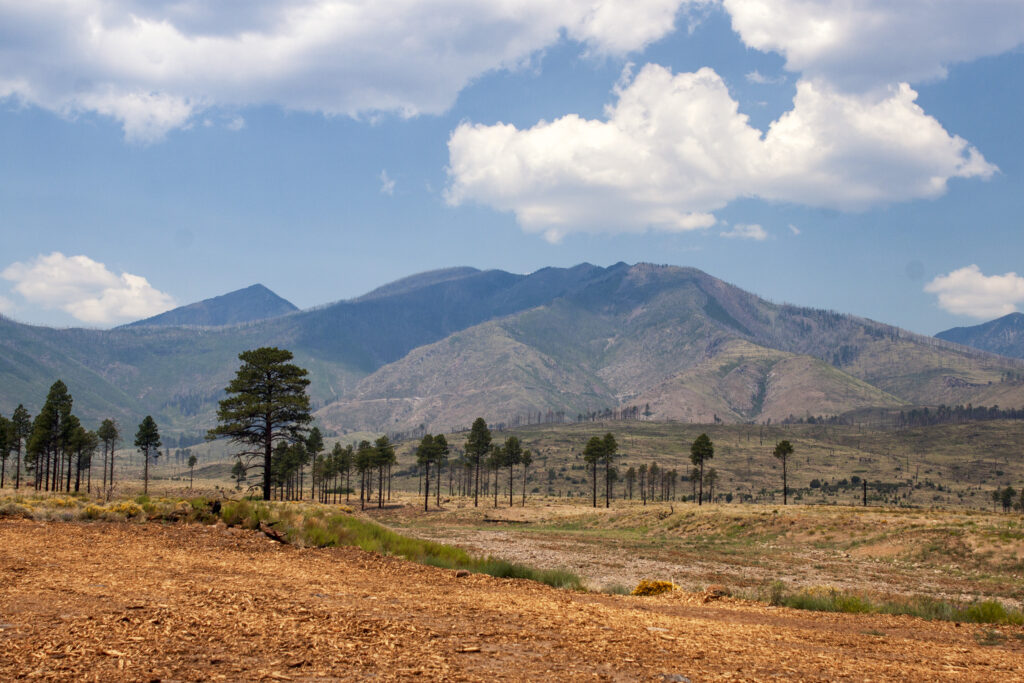
What Flagstaff and many western U.S. communities are also struggling with is the long reach of a wildfire, the slow disaster that expresses itself months, years or even decades after the flames are extinguished. The recovery in Flagstaff is instructive – a testament to the risks of an altered landscape, the coalition-building and public outreach required to address them, and the high cost of reconstruction.
The deadliest and most destructive of these post-wildfire hazards are the floods, landslides, and debris flows that are wrought by water. The hazards are particularly acute in the monsoon-influenced regions of the Southwest.
Last month in Ruidoso, New Mexico, the monsoon deposited several inches of rain over an area that burned the previous year in the South Fork and Salt fires. The Rio Ruidoso swelled five feet higher than its former record peak, killing three people.
Important infrastructure threads through these forests and watersheds. It is often in harm’s way. The Ruidoso flood hobbled the town’s wastewater system. In Washington state, the Yakima-Tieton Irrigation Canal was punctured by debris flows after the Retreat Fire last August. The irrigation district that operates the canal is seeking a $240 million replacement for a leaking water-delivery structure that serves 35,000 acres of mostly orchards.
The Hermit’s Peak-Calf Canyon Fire, in 2022, inflicted so much injury on the Gallinas River watershed that Congress granted Las Vegas, New Mexico, $140 million for a new water treatment plant to filter higher levels of sediment in its drinking water source. As more acres succumb to wildfire, the U.S. Forest Service expects one-third of western U.S. watersheds to experience a doubling of post-fire sediment flows in rivers by mid-century.
Even in Flagstaff such assets have required emergency repair. The Inner Basin pipeline, one of several city water sources, can fulfill as much as 20 percent of summer demand, said Brian Huntzinger, the water production manager for Flagstaff. After monsoon floods following the Pipeline Fire, the water supply pipeline was cracked in three places by debris and rocks, he said. The $16 million repair project included stabilizing some 45 sites where the structure crosses drainages.
“When you have rain occur on top of a burn scar,” Huntzinger said, “you have these just devastating floods where the whole slopes of a mountainside, these drainages, everything comes down the mountain because there’s nothing to hold that soil in.”
Assemble the team
In the aftermath of the Pipeline Fire, Coconino County embarked on an ambitious plan to hold in that soil and protect – within reasonable limits – the safety of the public works and roughly 1,500 private properties downstream of the burn scar.
The plan’s outline – a mix of natural and concrete systems – was relatively simple in concept. The ideas about stream channel restoration had been developed in Colorado by the hydrologist Dave Rosgen and proven in Coconino County in response to previous fires. But the restoration and engineering work required after the Pipeline Fire had not been deployed at such scale across so many watersheds, Andreani said.
The first objective was to retain as much soil and sediment on the forested uplands as possible. This would be done by repairing drainage channels that had been scoured into deep gullies. Then, in tandem, calm fast-moving water and spread it out across the landscape. Finally, down in the neighborhoods and along the highway, use hard infrastructure like pipes, culverts, and channels to direct the now-diminished flows away from homes, roads, and the local landfill.
Andreani knew who to call. By this time, Flagstaff and Coconino County had already been through watershed restoration and flood-control work after the Schultz Fire, in 2010, and the Museum Fire, in 2019. Like the Avengers in the Marvel movies, Andreani had people in place with expertise and experience. This restoration project would be her team’s “third rodeo.” It would be the largest yet.
JE Fuller, an engineering company, would do the flood modeling. One of its employees was drafted as part of the U.S. Forest Service team evaluating the fire’s burn severity. Natural Channel Design Engineering, a Flagstaff-based firm, would sketch the watershed repairs. These treatments would be carried out on Forest Service land with the goal of protecting assets downstream. Civiltec Engineering would contribute the engineering work within the neighborhoods. Tiffany Construction, a contractor, would move the earth.
Andreani, meanwhile, was in contact with congressional representatives and local, state, and federal agencies to drum up financial support. The county needed outside money to cover a price tag that would rise into the low nine figures.
“If you’ve never been through it, you get so wrapped up like we did in just trying to figure out how to mitigate impacts to people’s homes, right?” Andreani said about flood hazards in the weeks and months after a wildfire. “So people have somewhere to go home at night, and they can at least try to get some sleep.” But funding is the grease that turns the wheel. “And so I just said, ‘No, we’re going to really hit the ground running. We’re going to make this ask.’”
The windfall that Andreani sought came through in December 2022 in the form of a congressional appropriation totaling about $100 million in an omnibus spending bill. About $30 million from other state and federal sources would trickle in later. But the major restoration work in the nine drainages could begin.
Slow it down, spread it out
The Pipeline Fire is one of several wildfires – including the Schultz Fire – that have remade the forests and watersheds northeast of Flagstaff in the last 15 years.
Before Schultz, the watersheds were “complacent,” to use a hydrology term. Rainfall did not produce much runoff. The water soaked into the ground. Allen Haden, an aquatic ecologist with Natural Channel Design, pulled up satellite photos from 1985 of the east side of the San Francisco Peaks, where the Pipeline and Schultz fires burned. No big channels are visible.
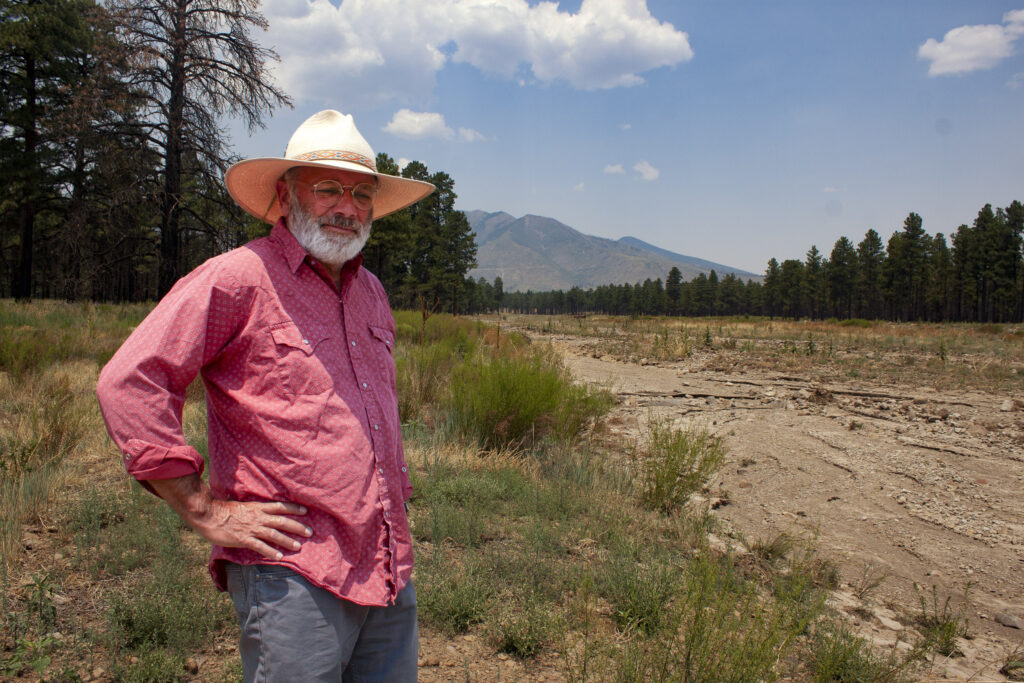
The Pachecos felt this, even if they didn’t notice it when they moved to Wupatki Trails in 2005. Not living in a valley or near a river, “we didn’t even think about flooding as an issue,” Ivan said.
After the Schultz Fire, the watershed was transformed, Haden said. “That complacency is eradicated overnight.”
The fire burned so hot in places that it cooked the soil, changing its chemical properties. “Once that happens, it becomes like a parking lot,” said Haden, who helped design the watershed repairs after the Pipeline Fire. These hydrophobic soils are common after severe fires in ponderosa pine forests like those around Flagstaff, he said.
The parking-lot effect showed up downstream. Peak stream flows after the Pipeline Fire increased 20-fold in some drainages. High-volume, fast-moving flows bite into the channels, eroding them and producing a firehose of sediment that moves downstream. “Once the gully process starts, things fall apart,” Haden said.
The goal of the restoration work was to reintroduce laziness to the watershed. That would be accomplished primarily using alluvial fans. These are natural features in stream channels, composed of loose sediment and rock. Though they look like a field of rubble, the post-Pipeline Fire fans were highly engineered for specific slopes and depths, Andreani said. Some of the reconstructed fans are massive, the largest measuring 40 acres. Nine fans were restored or expanded and 10 new ones were built. They are the first line of flood defense, intended to trap larger materials washing down the forest slopes and blunt the speed of the water.
Without the fans, any hard infrastructure within the residential areas would fill with sediment and be rendered useless, Andreani said. Not just immediately, but repeatedly. “In these burn areas, the debris and sediment doesn’t go away. It’s going to take decades.”
While the fan restoration work was happening, construction crews were working in the neighborhoods and within the Route 89 corridor to install channels and culverts. A 10-foot diameter pipe was placed in a tunnel bored beneath the highway. On Campbell Avenue homes were connected to the road by tiny bridges across a flood channel.
Constructing the neighborhood drainage structures was an exercise in patience. County officials and their partners held meetings and went door to door to secure easements from homeowners in the nine watersheds to build across their land, if necessary. Computer modeling was done to show that installing an engineered structure would not flood any home more than it would have flooded without the project.
The restoration work, broadly speaking, was intended to protect homes from two inches of rain in 45 minutes, an event that has a 4% chance of occurring each year. The modeling was conservative, though. And the alluvial fans, which are difficult to incorporate into the flood models, seem to be doing a better job than expected.
“We don’t over promise,” Andreani said. “But we see almost every system performs beyond what the modeling tells us it will do. And it’s because of those on-forest measures, the fan restorations in particular.”
An immediate test
Of the nine watersheds that were restored after the Pipeline Fire, some of the most creative problem solving took place in Wupatki Trails, Haden said. A single channel would not be enough to handle the expected flows. Instead, they converted an existing vegetated channel into a concrete structure that could withstand higher stresses and more water. They then split the flows coming from the tail of an expanded alluvial fan upslope of the houses. Water would go two directions around the neighborhood.
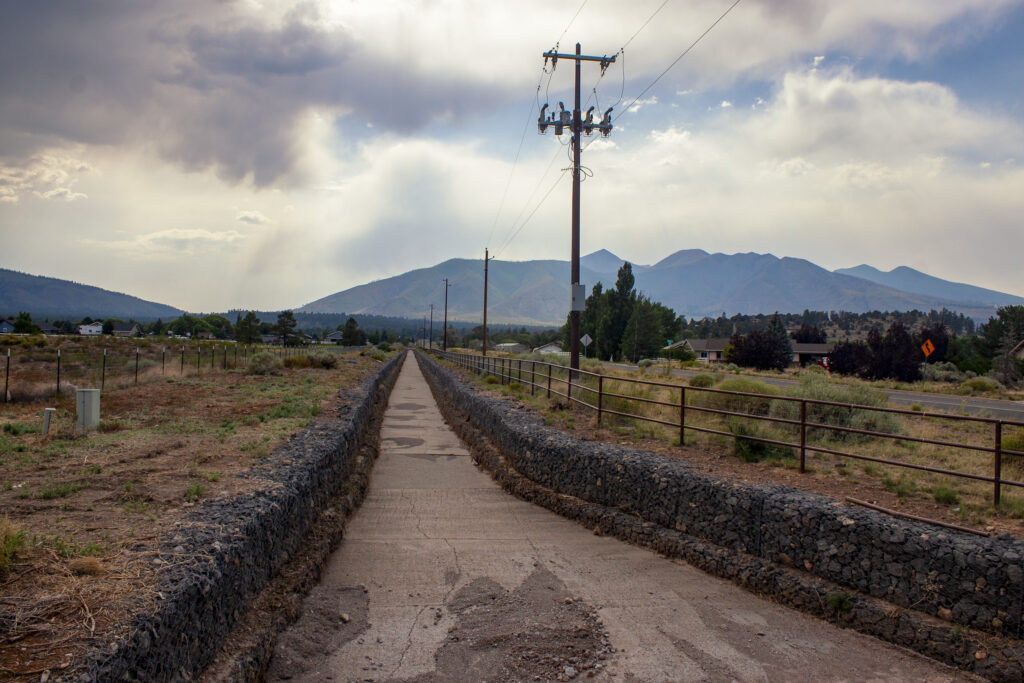
The contractors finished their work in Wupatki Trails in July 2023, just 12 months after the fire. And not a moment too soon. The flood-control work was put to an immediate test.
The next day a monsoon storm dumped roughly three inches on the slopes above Wupatki Trails, equivalent to a 100-year storm. Would the fix hold? Neighbors gathered anxiously on the banks of the engineered channel. Resident Danny Cobb recorded video of the water hurtling by. But it did not overtop.
Cobb’s property is near the spot where the channel splits. “It’s nothing short of amazing,” Cobb said about the flood-control work in the forest and neighborhood. “To have help within a year – that’s big.”
Down the block Ivan and Christy Pacheco also see the benefits. They gave up a small corner of their property for a drainage pipe. In return, the county added a berm to their backyard and regraded a four-foot-deep fissure that had been gouged by floods the previous summer.
Though the flood-control work has held so far, it has limits. The interventions likely cannot protect homeowners from the biggest floods, those generated by more than three inches of rain in an hour. Even as a warming planet is producing larger cloudbursts, engineers must work within the constraints of cost and existing infrastructure.
“You only have so much room,” Haden said.
Christy Pacheco recognizes that flood risk, though substantially reduced, is still present. The family’s horse that used to roam the backyard remains in Colorado, where it was sent after the fire.
“I still do not feel 100 percent safe,” she said.
This story was produced by Circle of Blue, in partnership with The Water Desk at the University of Colorado Boulder’s Center for Environmental Journalism.



